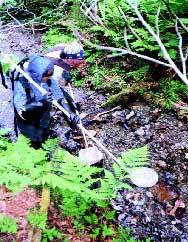\
6 - Diversion Plans / Forest Road Drainage Installation Practices in the Pacific Northwest
|
Forest Road Drainage Installation Practices
|
|
in the Pacific Northwest
|


|
|
| 6 - Diversion Plans
|
Step-By-Step Description,
Fish Removal |
Diverting streams or dewatering channels are effective tools when planning in-stream work outside fisheries windows, or in streams that present a high risk of sediment generation. Prepare a detailed work plan, assemble required materials, check the sediment control kit, and discuss possible emergency measures before work begins.
Steps of a Diversion/Dewatering Work Plan
- Remove Fish (below): this is required before instream work begins. If the installation takes a full day, schedule the fish removal for the day before. Check with fisheries agencies about timing of fish migrations in the stream, and minimize the duration of the stream blockage. Allow for fish passage if the project extends over several days.
- Construct Downstream Dam: it is primarily used to catch minor sediment or suspended particles in the water. It also provides an added level of comfort for unforeseen circumstances.
- Construct Upstream Dam: it is essential in any flow diversion as it must capture all the water flow. If a "pump-around" is used, a sufficient number of pumps (including spares) is required. Avoid using pumps if the job can not be completed in one shift.
- Complete Instream Work as planned. Always have a fully stocked sediment control kit on site to deal with the unexpected.
- Disassemble Upstream Dam but try to keep the diversion partially functional as long as possible. This allows the slow release of water from the dam and prevents a surge flow. Maintain downstream dam while the flows increase into the isolated stream section.
- Disassemble Downstream Dam when water quantity and quality return to normal levels. Remove the fish blockages and all materials and restore the site to its original state. Take pictures of the drainage structure for future inspections.
Fish Removal

Isolate the work site by placing fish netting upstream and downstream from the proposed crossing. Keep the isolated area big enough to be able to work safely and efficiently, but also small enough to minimize the efforts required for the fish removal. With additional fish netting, isolate a small area (approx. 3 meters long) upstream from the bottom fish blockage. The fish from this area are stunned with the electro-shocker, captured and released outside the work area. The electro-shocker crew leap-frogs upstream in 3 meter intervals until they reach the upstream fish netting. Although all fish should have been removed from the work site, a second sweep back downstream is necessary to capture any missed fish. Electroshocking is not reliable in water temperatures below 5°C (41°F). Therefore, drainage structure installations that require fish removal can only be completed during warmer temperatures.
PLANNING ISSUES
Diversion Plans 6 
|
INSTALLATION PRACTICES
|
©1999 - 2001 Flip Productions Limited
Used with permission by CulvertBC
|
